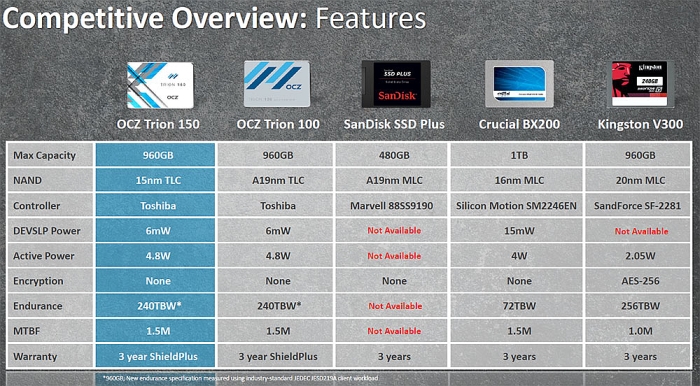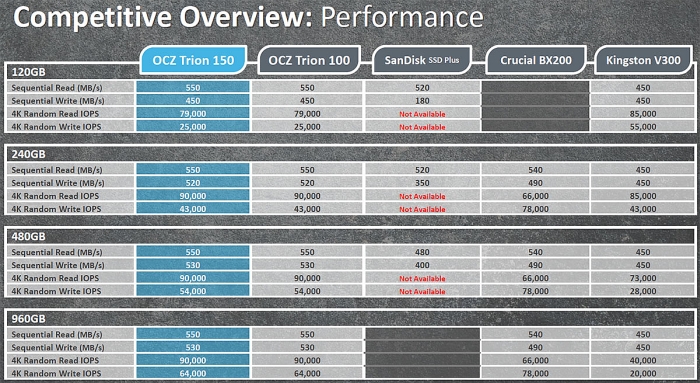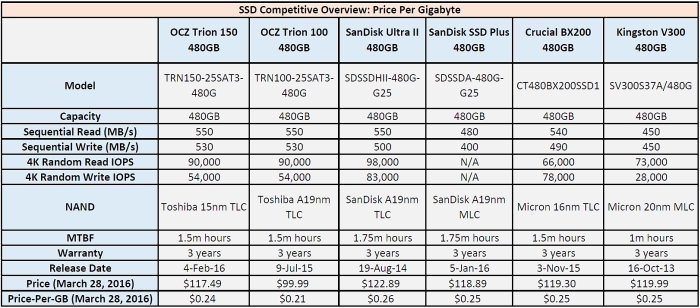Index
- OCZ Trion 150 480GB SSD Reviewed
- Performance Specifications
- Packaging
- Testing Methodology
- Benchmark Results - CrystalDiskMark x64 v5.1.2
- Benchmark Results - ATTO Disk Benchmark v3.05
- Benchmark Results – Iometer v1.1.0
- Benchmark Results – AS SSD Benchmark v.1.8.5636.37293
- Benchmark Results – PlayStation 4 SSD vs HDD
- Price-per-Gigabyte Comparison (March 28, 2016)
- Conclusion
- All Pages
For its “competitive overview” presentation slide, OCZ is comparing the Trion 150 series (15-nanometer TLC NAND flash) against its previous Trion 100 series (Advanced 19-nanometer TLC NAND flash), along with the SanDisk SSD Plus (Advanced 19-nanometer MLC NAND flash), the Crucial BX200 (16-nanometer MLC NAND flash), and the Kingston V300 (20-nanometer MLC NAND flash). Therefore, makes sense to compare any performance-per-dollar ratings with these particular drives in mind. We will be focusing particularly on 480GB capacity variants.

(OCZ Trion 150 competitive SSD overview. Larger image here.)
(OCZ Trion 150 competitive performance overview. Larger image here.)
The OCZ Trion 150 480GB is priced at just $117.49 ($0.24-per-gigabyte), making it the most affordable 480GB drive on the chart and probably one of the most affordable we have seen. By comparison, the OCZ Trion 100 480GB is now $99.99 ($0.21-per-gigabyte), so a good question now becomes whether an upgrade to 15-nanometer TLC NAND flash is worth an extra $17 dollars over its 19-nanometer predecessor.
SSD Competitive Overview: Price-Per-Gigabyte as of March 28, 2016 (Larger image here.)
On the other hand, the SanDisk SSD Plus 480GB is now $118.89 ($0.25-per-gigabyte), roughly the same price as the Trion 150 480GB, but features much lower maximum sequential read and write performance.
OCZ did not include one of our favorite drives in its comparison chart, the SanDisk Ultra II, which is now $122.89 ($0.26-per-gigabyte). This drive is based on SanDisk’s second-generation 19nm 128Gbit TLC NAND flash and Marvell’s 88SS9189 eight-channel controller (480GB and 960GB models). The 480GB model comes with a 20GB “SLC-like” cache, called nCache 2.0, and features up to 550MB/s sequential reads, up to 500MB/s sequential writes, up to 98,000 IOPS random 4K reads and up to 80,000 IOPS random 4K writes. If we include SanDisk’s Ultra II 480GB into the lineup, it now becomes the fastest drive in terms of 4K random IOPS, surpassing the Trion 150 480GB by 8.16 percent more 4K random read performance and 35 percent more 4K random write performance.
SanDisk’s Ultra II drives also have several advanced flash management features including nCache 2.0, multi-page recovery, XOR recovery and “on chip copy,” which will copy “SLC-like” write blocks from non-volatile cache memory into TLC NAND flash.
Meanwhile, OCZ has a competing technology in its Vector, Trion 100 and Trion 150 SSD lineups called “Performance Mode” that uses about 1.5 percent of total TLC storage as “SLC-like” cache by writing only a single bit of data. This amounts to about 7.2GB of cache on the 480GB drive, or 14.5GB on the larger 960GB drive. As such, users who writing large datasets to solid state storage should consider using one of the larger capacity drives. Some reviews have shown that file size transfers above the 7.2GB cache size for the 480GB drive have almost doubled in speed over the Trion 100 simply due to the newer 15-nanometer TLC NAND flash. So if sustained large transfers are a big deal, then spending an extra $17 for the Trion 150 480GB over the Trion 100 480GB is definitely justified. However, we might still recommend using an MLC-based drive for sustained transfers with more file size variations, such as the OCZ Vector 180 480GB.




